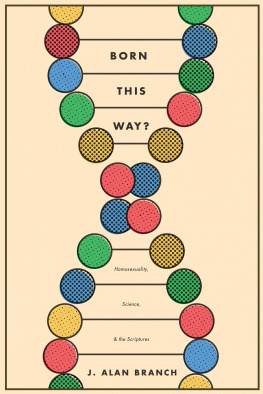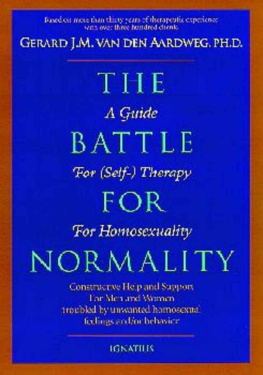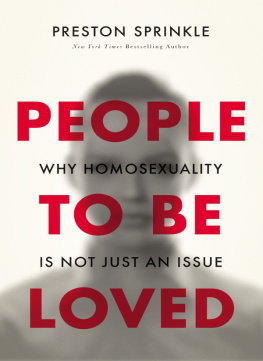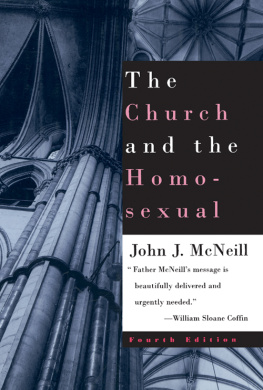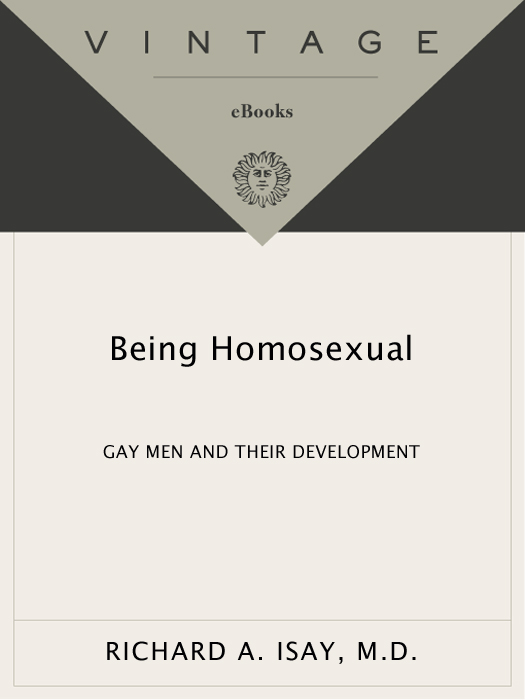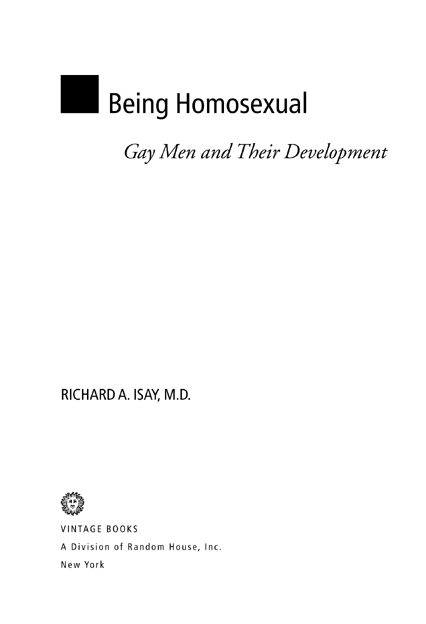FIRST VINTAGE BOOKS EDITION, MAY 2009
Copyright 1989, 2009 by Richard A. Isay
All rights reserved. Published in the United States by Vintage Books, a division of Random House, Inc., New York, and in Canada by Random House of Canada Limited, Toronto. Originally published in hardcover in the United States in slightly different form by Farrar, Straus, and Giroux, New York, in 1989.
Vintage and colophon are registered trademarks of Random House, Inc.
Grateful acknowledgment is made to Alfred A. Knopf, a division of Random House, Inc., and Faber and Faber Ltd., for permission to reprint an excerpt from Esthetique du Mal from The Collected Poems of Wallace Stevens, copyright 1954 by Wallace Stevens, copyright renewed 1982 by Holly Stevens.
Library of Congress Cataloging-in-Publication Data
Isay, Richard A.
Being homosexual : gay men and their development / by Richard A. Isay.
1st Vintage ed.
p. cm.
1. Gay menUnited StatesPsychology. 2. Gay menMental healthUnited States. 3. Gay menSexual behaviorUnited States. 4. Psychoanalysis and homosexualityUnited States. 5. Psychosexual developmentUnited States. I. Title.
HQ76.2.U5I834 2009
155.34dc22
2008045791
eISBN: 978-0-307-77350-0
Author photograph Gordon Harrell
www.vintagebooks.com
v3.1_r1
To David and Joshua
The greatest poverty is not to live
In a physical world, to feel that ones desire
Is too difficult to tell from despair.
WALLACE STEVENS , Esthtique du mal
Contents
Acknowledgments
, based on the chapter Homosexuality in Homosexual and Heterosexual Men: Some Distinctions and Implications for Treatment, in Gerald Fogel, Frederick Lane, and Robert Liebert, eds., The Psychology of Men (New York: Basic Books, 1986), are reprinted here with the publishers permission.
Papers on which portions of this book are based have also been presented and discussed at meetings of the American Psychoanalytic Association, the Association for Psychoanalytic Medicine (New York), Boston Psychoanalytic Society and Institute, Canadian Psychoanalytic Society (Quebec English Branch), Chicago Psychoanalytic Society, North Carolina Psychoanalytic Society, Philadelphia Psychoanalytic Society, Psychoanalytic Association of New York, Pittsburgh Psychoanalytic Society, Washington Psychoanalytic Society, and the Western New England Psychoanalytic Society. I have also had the opportunity to discuss some of my ideas at Grand Rounds in the Departments of Psychiatry at the Allen Memorial Institute (Montreal), Cornell University Medical Center, North Shore University Hospital, Ottawa General Hospital, Roosevelt Hospital, St. Lukes Hospital, the University of California (San Francisco), and as the First Annual Lecturer at the San Francisco Postgraduate Institute of Psychoanalytic Psychotherapy on March 29, 1986.
I am also grateful for the opportunities I have had to discuss parts of this book at annual meetings of the American Psychiatric Association in 1986, 1987, and 1988 at a symposium on Homosexuality/Heterosexuality sponsored by the Kinsey Institute for Research (May 2225, 1986); at scientific meetings of the Gay Psychiatrists of New York (June 1986 and 1987); at a psychotherapy symposium sponsored by the Cambridge Hospital (June 4, 1988); and at the Second International Conference on Gay and Lesbian Health (July 1988).
Gordon Harrell has been indirectly responsible for many of the ideas and attitudes expressed in the book, and for much more as well. I am very grateful for everything he has given me.
Without Janes devotion and enthusiastic support, this book could not have been written. No words can adequately convey my appreciation to and of her.
Finally, it has been my patients, through their willingness to share with me their most private fears, pleasures, thoughts, and feelings, who made this book possible.
R.A.I.
Preface
I wrote Being Homosexual in the 1980s to delineate important aspects of the normal childhood and adolescent development of gay men and to describe a therapy that was not biased by the prevailing perspective that homosexuals were sexual deviants. The book was based on several papers I had published and presented at psychoanalytic and psychiatric meetings to counter the developmental theory that male homosexuality was caused by a binding mother who feminized her son or by an emotionally distant or absent father who had failed to provide him with an appropriate model of masculinity. Psychoanalysts believed that a child whose development was unimpeded by such aberrant parenting would become heterosexual.
My own history and that of my adult gay patients had convinced me that sexual orientation is inborn. My patients told me that they had been attracted to other boys or men from childhood, often when they were as young as six or seven, and that from an even earlier age they had felt different from other boys. And, as children, most of these men had not enjoyed rough-and-tumble play and many of them had preferred playing with girls more than other boys, which also suggested their inherent difference from typical boys.
By the time the book was published in 1989, there had already been some important empirical studies suggesting that homosexuality had a biological basis.
Twenty years ago, most psychoanalysts and many other therapists were still convinced that when homosexuals were in treatment, and understood and worked through the relationships they had as children with their mother or father, they could become heterosexual. Many of my gay patients had been in such therapies that had not only been unsuccessful in changing their sexual orientation, but had reinforced a conviction based on social bias that their love and passion were bad, sinful, or sick, further injuring their self-esteem. Today most analysts do not believe that homosexuals can become heterosexuals and no longer attempt to change sexual orientation. But psychoanalytic theory has not significantly changed and, like most people in our society, traditional analysts continue to believe that heterosexuality is the only normal outcome of psychosexual development. This theory will affect the way many heterosexual analysts and therapists listen to and respond to the problems of their gay patients.
In June 1982 the CDC had recognized a new form of pneumonia in gay men, but it was not until 1986 that there were clinical trials with AZT, the first treatment to offer any hope for people with AIDS. AIDS was usually fatal when was written. It was fueling anti-gay bias and contributing to the self hatred of gay men. Most of my patients were terrified of contracting the disease and of dying. The threat of AIDS was playing a deleterious role in their coming out and developing a positive identity.
I wrote in the first edition of this book that our society does not desire to see gay men in stable, responsible, mutually-gratifying relationships. Since then, there has been significant social change. Two states currently recognize same-sex marriage and several other states have either civil unions or domestic partnerships. But there are still more than twenty states that ban marriage, partnerships, and civil unions between gay people, and the federal government does not currently recognize any of these unions. In order to foster love within committed relationships and to enhance the psychological well being and physical health of gay men, it is important that all the states and the federal government provide same-sex couples with the same rights and responsibilities as heterosexual couples.


